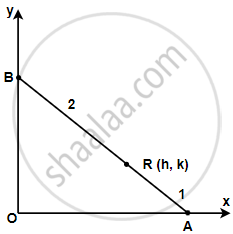Advertisements
Advertisements
प्रश्न
Point R (h, k) divides a line segment between the axes in the ratio 1:2. Find equation of the line.
उत्तर
Let AB be the line segment between the axes such that point R (h, k) divides AB in the ratio 1: 2.

Let the respective coordinates of A and B be (x, 0) and (0, y).
Since point R (h, k) divides AB in the ratio 1: 2, according to the section formula,
(h, k) = `(1 xx 0 + 2 xx x)/(1 + 2), (1 xx y + 2 xx 0)/(1 + 2)`
= (h, k) = `((2x)/3, y/3)`
= `h = (2x)/3 and k = y/3`
= x = `(3h)/2 and y = 3k`
Therefore, the respective coordinates of A and B are `((3h)/2,0)` and (0, 3k).
Now, the equation of line AB passing through points `((3h)/2,0)` and (0, 3k) is
(y - 0) = `(3k - 0)/(0 - (3h)/2) (x - (3h)/2)`
y = `(2k)/h (x - (3h)/2)`
hy = `-(2k)/h (x - (3h)/2)`
hy = -2kx + 3hk
i.e., 2kx + hy = 3hk
Thus, the required equation of the line is 2kx + hy = 3hk.
APPEARS IN
संबंधित प्रश्न
Find the equation of the line which satisfy the given condition:
Write the equations for the x and y-axes.
Find the equation of the line which satisfy the given condition:
Passing through the point (–4, 3) with slope `1/2`.
Find the equation of the line which satisfy the given condition:
Passing though (0, 0) with slope m.
Find the equation of the line which satisfy the given condition:
Passing though `(2, 2sqrt3)` and is inclined with the x-axis at an angle of 75°.
Find the equation of the line which satisfy the given condition:
Intersects the x-axis at a distance of 3 units to the left of origin with slope –2.
Find the equation of the line which satisfy the given condition:
Passing through the points (–1, 1) and (2, –4).
Find the equation of the line which is at a perpendicular distance of 5 units from the origin and the angle made by the perpendicular with the positive x-axis is 30°
The vertices of ΔPQR are P (2, 1), Q (–2, 3) and R (4, 5). Find equation of the median through the vertex R.
Find equation of the line passing through the point (2, 2) and cutting off intercepts on the axes whose sum is 9.
Find equation of the line through the point (0, 2) making an angle `(2pi)/3` with the positive x-axis. Also, find the equation of line parallel to it and crossing the y-axis at a distance of 2 units below the origin.
P (a, b) is the mid-point of a line segment between axes. Show that equation of the line is `x/a + y/b = 2`
By using the concept of equation of a line, prove that the three points (3, 0), (–2, –2) and (8, 2) are collinear.
Find the values of q and p, if the equation x cos q + y sinq = p is the normal form of the line `sqrt3 x` + y + 2 = 0.
Find the image of the point (3, 8) with respect to the line x + 3y = 7 assuming the line to be a plane mirror.
If the lines y = 3x + 1 and 2y = x + 3 are equally inclined to the line y = mx + 4, find the value of m.
Classify the following pair of line as coincident, parallel or intersecting:
2x + y − 1 = 0 and 3x + 2y + 5 = 0
Classify the following pair of line as coincident, parallel or intersecting:
x − y = 0 and 3x − 3y + 5 = 0]
Classify the following pair of line as coincident, parallel or intersecting:
3x + 2y − 4 = 0 and 6x + 4y − 8 = 0.
Prove that the lines \[\sqrt{3}x + y = 0, \sqrt{3}y + x = 0, \sqrt{3}x + y = 1 \text { and } \sqrt{3}y + x = 1\] form a rhombus.
Find the equation to the straight line parallel to 3x − 4y + 6 = 0 and passing through the middle point of the join of points (2, 3) and (4, −1).
Prove that the lines 2x − 3y + 1 = 0, x + y = 3, 2x − 3y = 2 and x + y = 4 form a parallelogram.
Find the angle between the lines x = a and by + c = 0..
Prove that the area of the parallelogram formed by the lines 3x − 4y + a = 0, 3x − 4y + 3a = 0, 4x − 3y− a = 0 and 4x − 3y − 2a = 0 is \[\frac{2}{7} a^2\] sq. units..
Show that the diagonals of the parallelogram whose sides are lx + my + n = 0, lx + my + n' = 0, mx + ly + n = 0 and mx + ly + n' = 0 include an angle π/2.
Three vertices of a parallelogram taken in order are (−1, −6), (2, −5) and (7, 2). The fourth vertex is
